 Facebook
Facebook
 X
X
 Instagram
Instagram
 TikTok
TikTok
 Youtube
Youtube
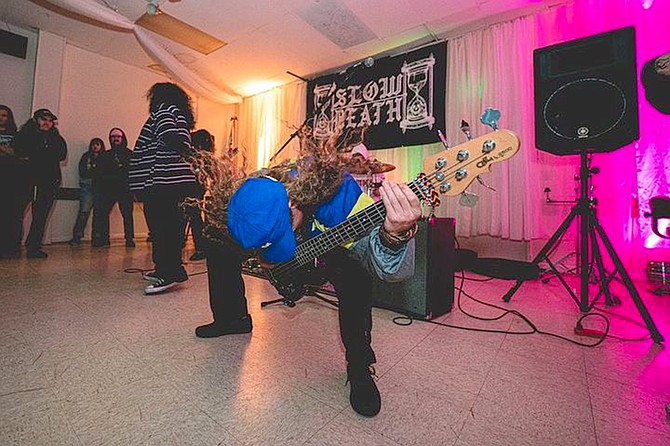
On May 11, the Federal Department of Health and Human Services will end the Covid public health emergency. But the bureaucratic behemoth is a slow-footed beast; John Q. Public knows the pandemic ended some time ago — though there may be some debate about exactly what it was that tipped him off. Does spring begin with the first robin, the first desert wildflower, or the first grunion run? Did Covid end with the mask mandate repeal, the return to live theater, or the blaring rebirth of live music? Here at the Reader, we’re going with the latter two, and in honor of the upcoming End of the Emergency, we’re highlighting a few personal favorites in those departments — including one or two you might have missed.
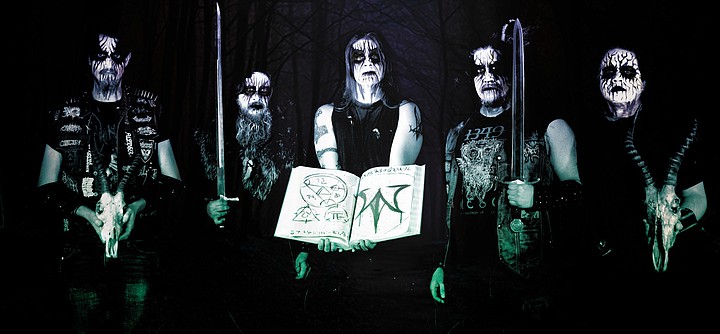
Mythraeum
San Diego’s Mythraeum represented the U.S.A. this past summer at Wacken Open Air, the most highly regarded festival of its kind in Germany. Getting to the fest meant making conquests in a battle of the bands, with two shows in San Diego and one in Los Angeles. That reserved a spot for the band and merited a thousand-dollar check from the organizer. But the balance of fare, plus the cost of accommodations, was on Mythraeum. Merch sales and donations covered part of the remaining costs, but each band member still wound up paying $750 out-of-pocket. According to vocalist Plague (Anthony Vivoli), it was worth it. “Wacken is the heavy metal holy land. All of us have dreamed of attending this festival for as long as we’ve loved this kind of music. To say that our first-time attending was as performers is beyond surreal.” The band’s latest offering, Halls of Mythras, is available through M-Theory Audio, and they’ll be playing Brick by Brick on June 17.
— Spike Steffenhagen
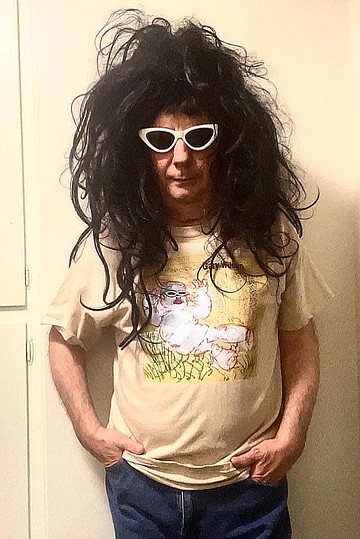
Gary Wilson
Amiable weirdo and longtime San Diego resident Gary Wilson has fourteen albums under his belt — when he wears one. He’s discoursed long and sinister over real and/or fantasized girlfriends, real and/or fantasized late-night walks and drives, and his long-running duck fixation. His chaotic live shows often feature paint and/or flour, dumped out in front of whirling floor fans. But for his new album, he’s tackling a new favored obsession. The Marshmallow Man, scheduled for release this summer, harkens back to his childhood in Endicott, New York. “As a child, I enjoyed marshmallows,” he reminisces. And the new outing promotes “perhaps another side of Gary Wilson. A more gentle side.” The Hillcrest local, who played almost all the instruments on Marshmallow, takes in some local color for inspiration as well. “I still enjoy the original Filippi’s on India Street. Recently did some San Diego shows at the Observatory and the Casbah. I enjoy late night walks to Ralph’s grocery store.” For heavy artistic inspiration this time out, our man cites “watching the 1959 movie A Summer Place and listening to ‘The Lark Ascending’ by Ralph Vaughan Williams.” As for new gigs, “Most likely. About flour and paint, you never know. It could happen.”
— Andrew Hamlin
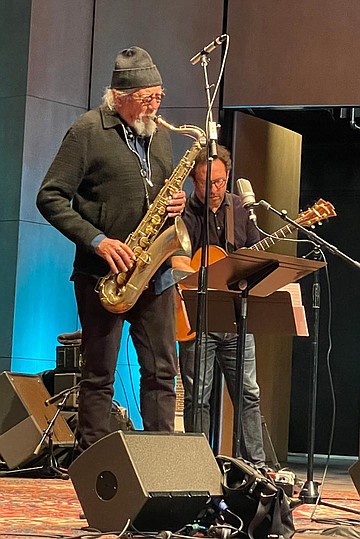
Charles Lloyd
Saxophonist Charles Lloyd has long been revered in jazz, ever since he broke into the national consciousness in the mid-1960s. All these years later, he continues to inspire audiences with performances that border on spiritual experiences. When Lloyd and his much younger bandmates (Gerald Clayton, piano; Anthony Wilson, guitar; Larry Grenadier, bass) casually arrived on stage at the Irwin M. Jacobs Qualcomm Hall on March 17, the sold-out crowd seemed captivated before the first note was played. Lloyd began a capella, with slow, deliberately pensive and breathy tones. The band began to fill in with support around him. He took a long, pointed solo, followed by virtuosic statements from Wilson and Clayton. We were 20 minutes into the first piece before I really noticed that there wasn’t a drummer on stage. That’s how effective Grenadier was in holding things together. The hall seats more than 500 patrons, and the sound in the room was crystal clear. Lloyd used the opening piece as a template for the evening, which concentrated on ballads — with the exception of one spritely tune on the flute in a Latin-tinged vein. Afterward, many patrons commented on the church-like spirit of it all.
— Robert Bush
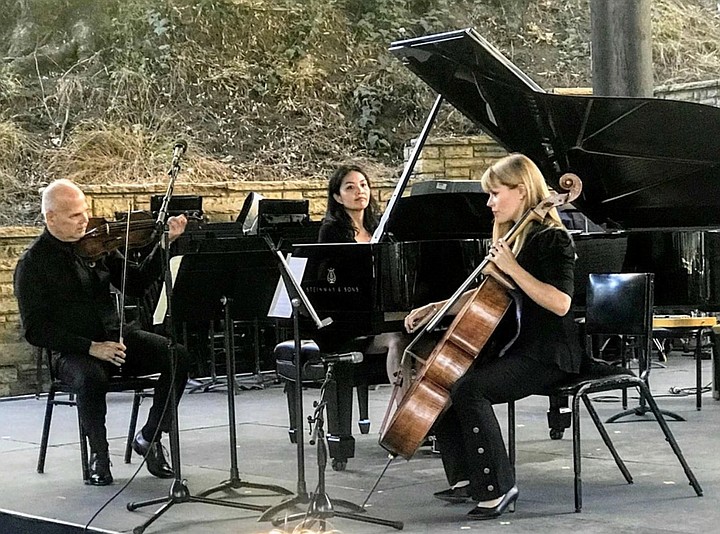
The Aviara Trio
Ines Irawati is one of San Diego’s brightest classical music stars. As a teenager, the pianist came to the United States from Indonesia to study at the Cleveland Institute of Music. (She confesses to having struggled with English vocabulary assignments — because she didn’t know what the word “vocabulary” meant.) For several years, Ines was the go-to coach for opera singers, but in recent days, she has focused on being a concert pianist. She is also active as a chamber musician with the Aviara Trio. I was blown away when I caught one of their performances at a San Diego Library Concert. I had no idea a group of this caliber was on hand in San Diego. The Aviara Trio performs extensively in Southern California, including the Hollywood Bowl, where they were a part of the LA Philharmonic’s 100-year anniversary celebration. They’ll be playing at the Del Mar Civic Center on April 6.
—Garrett Harris
North County stage truck
It was in the early days of Covid when Kevin Williams, his wife Summer, and their son Reagan set out to keep the music alive. All three are stalwarts of the North County music scene, with a preference for roots, rockabilly and blues. Clubs were closed, and bands had no place to play. So Williams, who lives in Carlsbad, put his mechanical skills to the test and built a stage, complete with lights and sound, on an old flatbed truck. In no time at all, he and his family were cruising around town, parking the truck in the village or at the beach, and jamming with such celebrated musicians as Thomas Yearsley of the Paladins, Chicago bluesman Mondo Cortez, slide guitar hero Johnny Vernazza, and Oceanside’s own Stevie Salas. “I did it out of anger,” Williams says. His son suffers from colitis, and was in and out of hospitals as a child. Music was his lifeline. “He was playing three to five nights a week. Then, bang, nothing. So I did something about it — I didn’t want anything to stop Reagan from playing.” These days, clubs are back open, but the Williams family’s traveling concerts remain a weekly fixture at parties and events throughout North County. “It’s become kind of its own thing,” Williams says.
— Thomas K. Arnold
Pacific Lyric Association
The Pacific Lyric Association was founded by Carlos and Terry Oliva. The organization puts on at least one fully staged opera per year and has a monthly Fourth Wednesday concert at Forgotten Barrel Winery in Escondido. Their most recent opera production was Georg Bizet’s Carmen, with performances at the California Center for the Arts Escondido and the Joan B. Kroc Theater in San Diego. The productions are refreshingly traditional, and feature Southern California talent. Pacific Lyric Association presents operas that people love. From Carmen to Rigoletto to Cavalleria Rusticana, the Association is doing its part to keep opera present and accounted for in San Diego.
— Garrett Harris

Wong’s Dragon Room
I have likely driven by this place a gazillion times since we moved out here in 2020, but even though the building’s outer façade is about as loud and inviting as an outer façade can be, I had never really noticed either the Dragon Room or its adjacent restaurant, Wong’s Golden Palace. Then I accepted an invite from my buddy to check out Joey Harris and The Mentals performing at the venue in early February, and I was shocked by how close the venue was to our house. Once we entered the bar, it was love at first site. There are the dingier, modern bars that people refer to as “dive bars,” and then there are true, trapped in a time-warp DIVE BARS.
The Dragon Room definitely falls into the latter category. Catching Joey Harris there on that night and listening to him performing some songs from his old band, the Beat Farmers, felt about as close to experiencing a 1980s-era Beat Farmers gig as you could get. The interior design motif seems about as influenced by the Double Deuce bar from the 1989 film Road House as you are likely to find in San Diego. It’s loud, it’s sweaty, and people are drunk and dancing to loud rock music and spilling drinks and having a grand old time. The only thing missing is the chain link fence protecting the band from flying beer bottles.
— Dryw Keltz
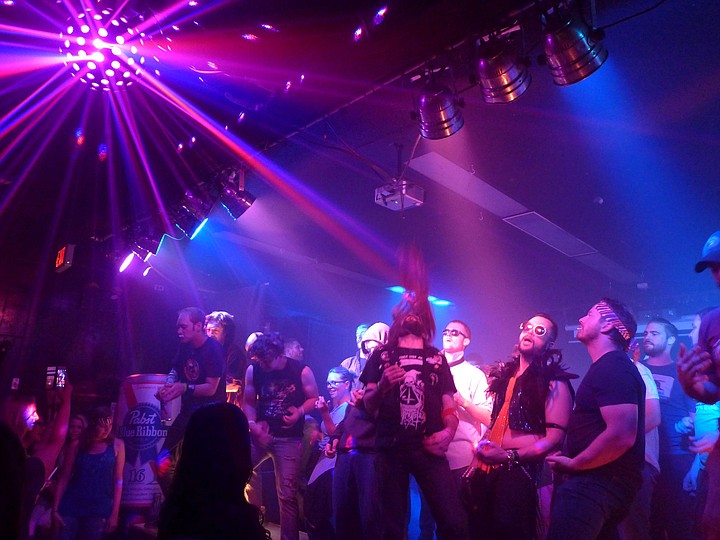
The Merrow
Paul Smith took over the Hillcrest space formerly occupied by the San Diego Sports Club way back in 2008. The bar he opened was initially called The Ruby Room, but it had transitioned to the Merrow by 2013. The venue isn’t too far removed from other local bars-with-a-stage such as Soda Bar, the Casbah, and Space Bar, but it does seem to fly a bit more under the radar, making it something of a covert surprise.
The Merrow has had success with underground dance nights such as Club Hemlock, Club Sabbat, Ascension, and the free-of-charge Blue Monday while still serving as showcase for local bands such as Fistfights With Wolves and national acts such as Boris Pelekh of Gogol Bodello. The parking lot next to the venue is an added bonus. For most of the year, it serves as a potential opportunity for patrons to actually score a parking spot in Hillcrest, but on a handful of dates, it gives the Merrow an expanded space to host larger crowds for events such as the US Air Guitar Championships.
— Dryw Keltz
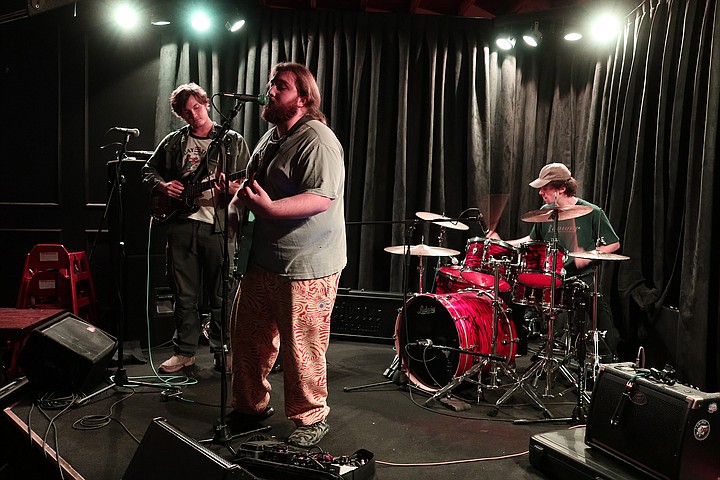
The Pour House
It’s Saturday night, and I’m at the Pour House in Oceanside — one of the few San Diego area nightclubs that books mostly local rock bands that write and play their own music. The stage is crammed into a corner, and you have to maneuver yourself past a pool table and an L-shaped bar to get to the live music area. Tonight’s a special night, as two of the three bands have family ties. My middle son, Conner, plays bass with Almost Restricted, an alt-rock band led by guitarist-singer-songwriter Andrew Bush and featuring Sean Gahman on drums. And my youngest son, Hunter, plays drums with the Renters, an Oceanside punk ensemble led by guitarist-vocalist Johnny Sudetta and featuring guitarists Seth Ahumada and Tyler Miller, and bassist Jacob Sepe. (Sudetta, incidentally, is the grandson and namesake of the instrumental surf-rock pioneer who recorded as Johnny Fortune).
As I position myself on the fringe of the dance floor and see a mass of bodies one-third my age in the makeshift mosh pit, I am transported back more than 40 years, to the time I was the rock critic for the Los Angeles Times and San Diego Magazine and spent most weekends at the Spirit, which, like the Pour House, was a haven for original live music. It’s somehow comforting that unless I look in the mirror, it could be 1981 again.
— Thomas K. Arnold
Opera Wednesdays
Opera Wednesdays at the La Jolla Community Center started in the spring of 2014 as a response to the proposed shutdown of the San Diego Opera by then-general director Ian Campbell. Nine years and one pandemic later, they are still going strong. Opera Wednesdays, which take place on the second Wednesday of the month, focus on presenting Southern California opera talent. The format can vary from month to month. On any given Opera Wednesday, one might hear a soprano, a mezzo, a tenor, and a bass or baritone sing selections of arias. It’s also possible to hear two sopranos and a baritone do duets or full scenes from operas. Art songs and Lieder are also on the menu from time to time. The setting is casual, with an indoor/outdoor area providing the operatic stage. Refreshments are served.
— Garrett Harris
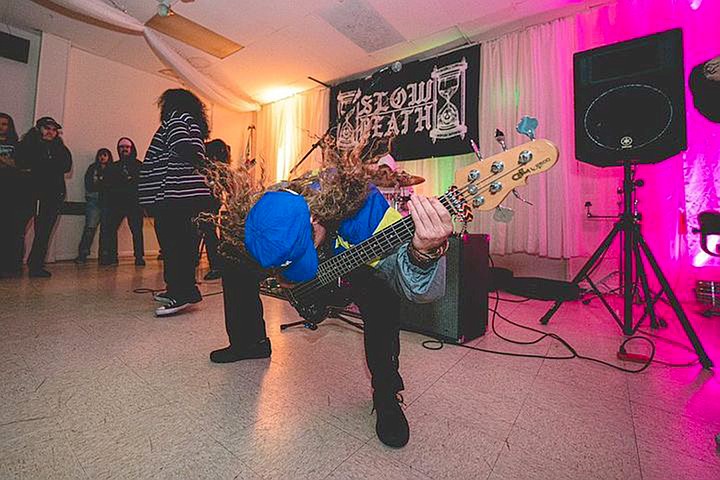
Slow Death Promotions
Not since The Industry boarded up shop (due to too many noise complaints) in 2017 has the South Bay had a go-to spot for hungry punks to perform/mosh. Dripping from a similar vein as The Industry, home-grown punk Elton Bernache started the promotion Slow Death last April for local San Diego acts to have a place to call home. The new all-ages promotion operates out of the Fraternal Order of Eagles community center in National City, and recently secured an outdoor venue with non-profit organization Vision Culture for a second space to host shows.
Vision Culture is a foundation with values rooted in youth empowerment and community; the collaboration between the two makes sense, given each organization’s community outreach efforts. Over the past year, Slow Death has put on several benefit shows, as well as multiple food and toy drives. Since opening the doors, the National City promotion has hosted over twenty events, with no end in sight — and they can be as loud and rowdy as they damn well please. Bernache just asks that no more holes get punched in the walls: between running a new punk promotion, working full-time, playing in multiple bands, and being a new dad, it’s tough for him to get in there to patch that shit up.
— Andrew Hamlin
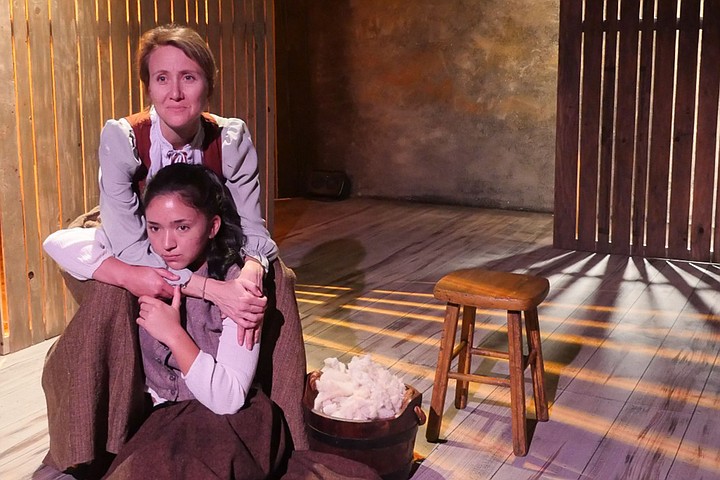
Moxie Theater
Theater people are notoriously superstitious — viz. ghost lights, “break a leg,” The Scottish Play, etc. So I’m hesitant to say anything about Moxie while the women-centric theater is in something of a delicate condition — co-founder and executive artistic director Jennifer Eve Thorn has announced plans to step down next June, and it’s always a tricky business when a creator entrusts her creation to someone new. But the end of an era is a fitting time for encomiums, and I’m happy to report that during my (admittedly brief) run as theater critic here at the Reader, no small theater — and perhaps no theater, period — has been as consistently excellent in its selection and presentation of material.
Thorn’s star turn as Joan of Arc’s mystified mom in Mother of the Maid stands out in memory, but it’s all been solid stuff: the clash of politics and generations in IRON and Birds of North America, the small-scale effects of a large-scale disaster in The Children, and the funnily frank sexual investigations of The Pleasure Trials. I’m naturally suspicious of “theater of a certain sort,” which makes their success all the more remarkable. Here’s hoping Thorn’s successor keeps up with the leg-breaking.
— Matthew Lickona

The Old Globe
Where Moxie does a lot with a little, The Old Globe does a lot with a lot. So yeah, maybe it’s a bit silly to go gushing over San Diego’s most famous theater. But their recent productions of Under a Baseball Sky and Bob Fosse’s Dancin’ served as an excellent reminder of just how good the Globe is at all the aspects that, ahem, set the stage: sound, lighting, costumes, and oh my goodness yes, set design. Theater is magic: it doesn’t take much to make an audience believe that a couple of fake walls and a few chairs constitute a fully furnished house.
But when the Old Globe puts its considerable resources to work building an urban showcase for a dance visionary or giving felt life to the story of a haunted vacant lot, the results are, at least occasionally, so immersive that your humble critic has to remember to pick up his pen. Of course, you’re not supposed to let all that scenery chew the actors, but next time you attend, maybe take a moment to appreciate the way it enhances their efforts.
— Matthew Lickona


On May 11, the Federal Department of Health and Human Services will end the Covid public health emergency. But the bureaucratic behemoth is a slow-footed beast; John Q. Public knows the pandemic ended some time ago — though there may be some debate about exactly what it was that tipped him off. Does spring begin with the first robin, the first desert wildflower, or the first grunion run? Did Covid end with the mask mandate repeal, the return to live theater, or the blaring rebirth of live music? Here at the Reader, we’re going with the latter two, and in honor of the upcoming End of the Emergency, we’re highlighting a few personal favorites in those departments — including one or two you might have missed.

Mythraeum
San Diego’s Mythraeum represented the U.S.A. this past summer at Wacken Open Air, the most highly regarded festival of its kind in Germany. Getting to the fest meant making conquests in a battle of the bands, with two shows in San Diego and one in Los Angeles. That reserved a spot for the band and merited a thousand-dollar check from the organizer. But the balance of fare, plus the cost of accommodations, was on Mythraeum. Merch sales and donations covered part of the remaining costs, but each band member still wound up paying $750 out-of-pocket. According to vocalist Plague (Anthony Vivoli), it was worth it. “Wacken is the heavy metal holy land. All of us have dreamed of attending this festival for as long as we’ve loved this kind of music. To say that our first-time attending was as performers is beyond surreal.” The band’s latest offering, Halls of Mythras, is available through M-Theory Audio, and they’ll be playing Brick by Brick on June 17.
— Spike Steffenhagen

Gary Wilson
Amiable weirdo and longtime San Diego resident Gary Wilson has fourteen albums under his belt — when he wears one. He’s discoursed long and sinister over real and/or fantasized girlfriends, real and/or fantasized late-night walks and drives, and his long-running duck fixation. His chaotic live shows often feature paint and/or flour, dumped out in front of whirling floor fans. But for his new album, he’s tackling a new favored obsession. The Marshmallow Man, scheduled for release this summer, harkens back to his childhood in Endicott, New York. “As a child, I enjoyed marshmallows,” he reminisces. And the new outing promotes “perhaps another side of Gary Wilson. A more gentle side.” The Hillcrest local, who played almost all the instruments on Marshmallow, takes in some local color for inspiration as well. “I still enjoy the original Filippi’s on India Street. Recently did some San Diego shows at the Observatory and the Casbah. I enjoy late night walks to Ralph’s grocery store.” For heavy artistic inspiration this time out, our man cites “watching the 1959 movie A Summer Place and listening to ‘The Lark Ascending’ by Ralph Vaughan Williams.” As for new gigs, “Most likely. About flour and paint, you never know. It could happen.”
— Andrew Hamlin

Charles Lloyd
Saxophonist Charles Lloyd has long been revered in jazz, ever since he broke into the national consciousness in the mid-1960s. All these years later, he continues to inspire audiences with performances that border on spiritual experiences. When Lloyd and his much younger bandmates (Gerald Clayton, piano; Anthony Wilson, guitar; Larry Grenadier, bass) casually arrived on stage at the Irwin M. Jacobs Qualcomm Hall on March 17, the sold-out crowd seemed captivated before the first note was played. Lloyd began a capella, with slow, deliberately pensive and breathy tones. The band began to fill in with support around him. He took a long, pointed solo, followed by virtuosic statements from Wilson and Clayton. We were 20 minutes into the first piece before I really noticed that there wasn’t a drummer on stage. That’s how effective Grenadier was in holding things together. The hall seats more than 500 patrons, and the sound in the room was crystal clear. Lloyd used the opening piece as a template for the evening, which concentrated on ballads — with the exception of one spritely tune on the flute in a Latin-tinged vein. Afterward, many patrons commented on the church-like spirit of it all.
— Robert Bush

The Aviara Trio
Ines Irawati is one of San Diego’s brightest classical music stars. As a teenager, the pianist came to the United States from Indonesia to study at the Cleveland Institute of Music. (She confesses to having struggled with English vocabulary assignments — because she didn’t know what the word “vocabulary” meant.) For several years, Ines was the go-to coach for opera singers, but in recent days, she has focused on being a concert pianist. She is also active as a chamber musician with the Aviara Trio. I was blown away when I caught one of their performances at a San Diego Library Concert. I had no idea a group of this caliber was on hand in San Diego. The Aviara Trio performs extensively in Southern California, including the Hollywood Bowl, where they were a part of the LA Philharmonic’s 100-year anniversary celebration. They’ll be playing at the Del Mar Civic Center on April 6.
—Garrett Harris
North County stage truck
It was in the early days of Covid when Kevin Williams, his wife Summer, and their son Reagan set out to keep the music alive. All three are stalwarts of the North County music scene, with a preference for roots, rockabilly and blues. Clubs were closed, and bands had no place to play. So Williams, who lives in Carlsbad, put his mechanical skills to the test and built a stage, complete with lights and sound, on an old flatbed truck. In no time at all, he and his family were cruising around town, parking the truck in the village or at the beach, and jamming with such celebrated musicians as Thomas Yearsley of the Paladins, Chicago bluesman Mondo Cortez, slide guitar hero Johnny Vernazza, and Oceanside’s own Stevie Salas. “I did it out of anger,” Williams says. His son suffers from colitis, and was in and out of hospitals as a child. Music was his lifeline. “He was playing three to five nights a week. Then, bang, nothing. So I did something about it — I didn’t want anything to stop Reagan from playing.” These days, clubs are back open, but the Williams family’s traveling concerts remain a weekly fixture at parties and events throughout North County. “It’s become kind of its own thing,” Williams says.
— Thomas K. Arnold
Pacific Lyric Association
The Pacific Lyric Association was founded by Carlos and Terry Oliva. The organization puts on at least one fully staged opera per year and has a monthly Fourth Wednesday concert at Forgotten Barrel Winery in Escondido. Their most recent opera production was Georg Bizet’s Carmen, with performances at the California Center for the Arts Escondido and the Joan B. Kroc Theater in San Diego. The productions are refreshingly traditional, and feature Southern California talent. Pacific Lyric Association presents operas that people love. From Carmen to Rigoletto to Cavalleria Rusticana, the Association is doing its part to keep opera present and accounted for in San Diego.
— Garrett Harris

Wong’s Dragon Room
I have likely driven by this place a gazillion times since we moved out here in 2020, but even though the building’s outer façade is about as loud and inviting as an outer façade can be, I had never really noticed either the Dragon Room or its adjacent restaurant, Wong’s Golden Palace. Then I accepted an invite from my buddy to check out Joey Harris and The Mentals performing at the venue in early February, and I was shocked by how close the venue was to our house. Once we entered the bar, it was love at first site. There are the dingier, modern bars that people refer to as “dive bars,” and then there are true, trapped in a time-warp DIVE BARS.
The Dragon Room definitely falls into the latter category. Catching Joey Harris there on that night and listening to him performing some songs from his old band, the Beat Farmers, felt about as close to experiencing a 1980s-era Beat Farmers gig as you could get. The interior design motif seems about as influenced by the Double Deuce bar from the 1989 film Road House as you are likely to find in San Diego. It’s loud, it’s sweaty, and people are drunk and dancing to loud rock music and spilling drinks and having a grand old time. The only thing missing is the chain link fence protecting the band from flying beer bottles.
— Dryw Keltz

The Merrow
Paul Smith took over the Hillcrest space formerly occupied by the San Diego Sports Club way back in 2008. The bar he opened was initially called The Ruby Room, but it had transitioned to the Merrow by 2013. The venue isn’t too far removed from other local bars-with-a-stage such as Soda Bar, the Casbah, and Space Bar, but it does seem to fly a bit more under the radar, making it something of a covert surprise.
The Merrow has had success with underground dance nights such as Club Hemlock, Club Sabbat, Ascension, and the free-of-charge Blue Monday while still serving as showcase for local bands such as Fistfights With Wolves and national acts such as Boris Pelekh of Gogol Bodello. The parking lot next to the venue is an added bonus. For most of the year, it serves as a potential opportunity for patrons to actually score a parking spot in Hillcrest, but on a handful of dates, it gives the Merrow an expanded space to host larger crowds for events such as the US Air Guitar Championships.
— Dryw Keltz

The Pour House
It’s Saturday night, and I’m at the Pour House in Oceanside — one of the few San Diego area nightclubs that books mostly local rock bands that write and play their own music. The stage is crammed into a corner, and you have to maneuver yourself past a pool table and an L-shaped bar to get to the live music area. Tonight’s a special night, as two of the three bands have family ties. My middle son, Conner, plays bass with Almost Restricted, an alt-rock band led by guitarist-singer-songwriter Andrew Bush and featuring Sean Gahman on drums. And my youngest son, Hunter, plays drums with the Renters, an Oceanside punk ensemble led by guitarist-vocalist Johnny Sudetta and featuring guitarists Seth Ahumada and Tyler Miller, and bassist Jacob Sepe. (Sudetta, incidentally, is the grandson and namesake of the instrumental surf-rock pioneer who recorded as Johnny Fortune).
As I position myself on the fringe of the dance floor and see a mass of bodies one-third my age in the makeshift mosh pit, I am transported back more than 40 years, to the time I was the rock critic for the Los Angeles Times and San Diego Magazine and spent most weekends at the Spirit, which, like the Pour House, was a haven for original live music. It’s somehow comforting that unless I look in the mirror, it could be 1981 again.
— Thomas K. Arnold
Opera Wednesdays
Opera Wednesdays at the La Jolla Community Center started in the spring of 2014 as a response to the proposed shutdown of the San Diego Opera by then-general director Ian Campbell. Nine years and one pandemic later, they are still going strong. Opera Wednesdays, which take place on the second Wednesday of the month, focus on presenting Southern California opera talent. The format can vary from month to month. On any given Opera Wednesday, one might hear a soprano, a mezzo, a tenor, and a bass or baritone sing selections of arias. It’s also possible to hear two sopranos and a baritone do duets or full scenes from operas. Art songs and Lieder are also on the menu from time to time. The setting is casual, with an indoor/outdoor area providing the operatic stage. Refreshments are served.
— Garrett Harris

Slow Death Promotions
Not since The Industry boarded up shop (due to too many noise complaints) in 2017 has the South Bay had a go-to spot for hungry punks to perform/mosh. Dripping from a similar vein as The Industry, home-grown punk Elton Bernache started the promotion Slow Death last April for local San Diego acts to have a place to call home. The new all-ages promotion operates out of the Fraternal Order of Eagles community center in National City, and recently secured an outdoor venue with non-profit organization Vision Culture for a second space to host shows.
Vision Culture is a foundation with values rooted in youth empowerment and community; the collaboration between the two makes sense, given each organization’s community outreach efforts. Over the past year, Slow Death has put on several benefit shows, as well as multiple food and toy drives. Since opening the doors, the National City promotion has hosted over twenty events, with no end in sight — and they can be as loud and rowdy as they damn well please. Bernache just asks that no more holes get punched in the walls: between running a new punk promotion, working full-time, playing in multiple bands, and being a new dad, it’s tough for him to get in there to patch that shit up.
— Andrew Hamlin

Moxie Theater
Theater people are notoriously superstitious — viz. ghost lights, “break a leg,” The Scottish Play, etc. So I’m hesitant to say anything about Moxie while the women-centric theater is in something of a delicate condition — co-founder and executive artistic director Jennifer Eve Thorn has announced plans to step down next June, and it’s always a tricky business when a creator entrusts her creation to someone new. But the end of an era is a fitting time for encomiums, and I’m happy to report that during my (admittedly brief) run as theater critic here at the Reader, no small theater — and perhaps no theater, period — has been as consistently excellent in its selection and presentation of material.
Thorn’s star turn as Joan of Arc’s mystified mom in Mother of the Maid stands out in memory, but it’s all been solid stuff: the clash of politics and generations in IRON and Birds of North America, the small-scale effects of a large-scale disaster in The Children, and the funnily frank sexual investigations of The Pleasure Trials. I’m naturally suspicious of “theater of a certain sort,” which makes their success all the more remarkable. Here’s hoping Thorn’s successor keeps up with the leg-breaking.
— Matthew Lickona

The Old Globe
Where Moxie does a lot with a little, The Old Globe does a lot with a lot. So yeah, maybe it’s a bit silly to go gushing over San Diego’s most famous theater. But their recent productions of Under a Baseball Sky and Bob Fosse’s Dancin’ served as an excellent reminder of just how good the Globe is at all the aspects that, ahem, set the stage: sound, lighting, costumes, and oh my goodness yes, set design. Theater is magic: it doesn’t take much to make an audience believe that a couple of fake walls and a few chairs constitute a fully furnished house.
But when the Old Globe puts its considerable resources to work building an urban showcase for a dance visionary or giving felt life to the story of a haunted vacant lot, the results are, at least occasionally, so immersive that your humble critic has to remember to pick up his pen. Of course, you’re not supposed to let all that scenery chew the actors, but next time you attend, maybe take a moment to appreciate the way it enhances their efforts.
— Matthew Lickona
Comments